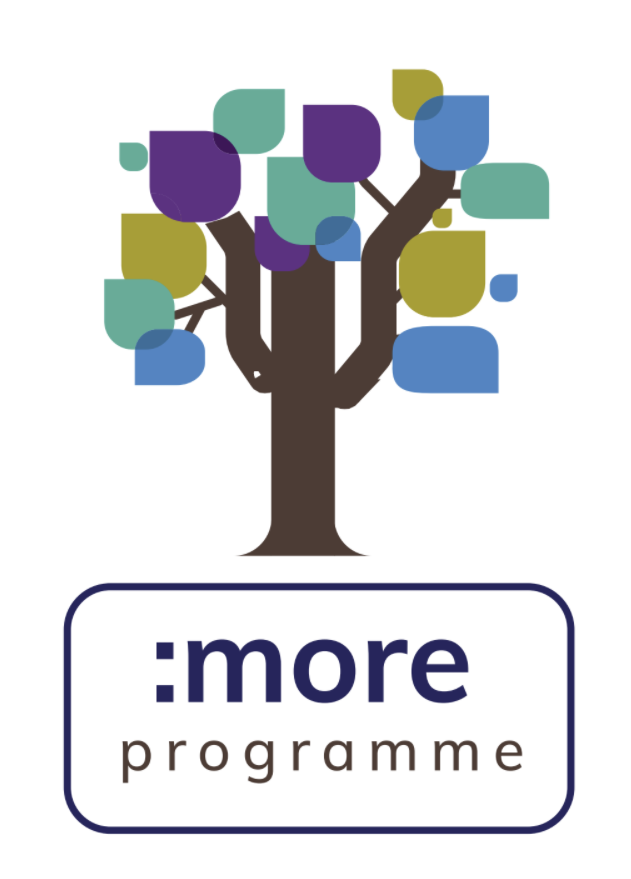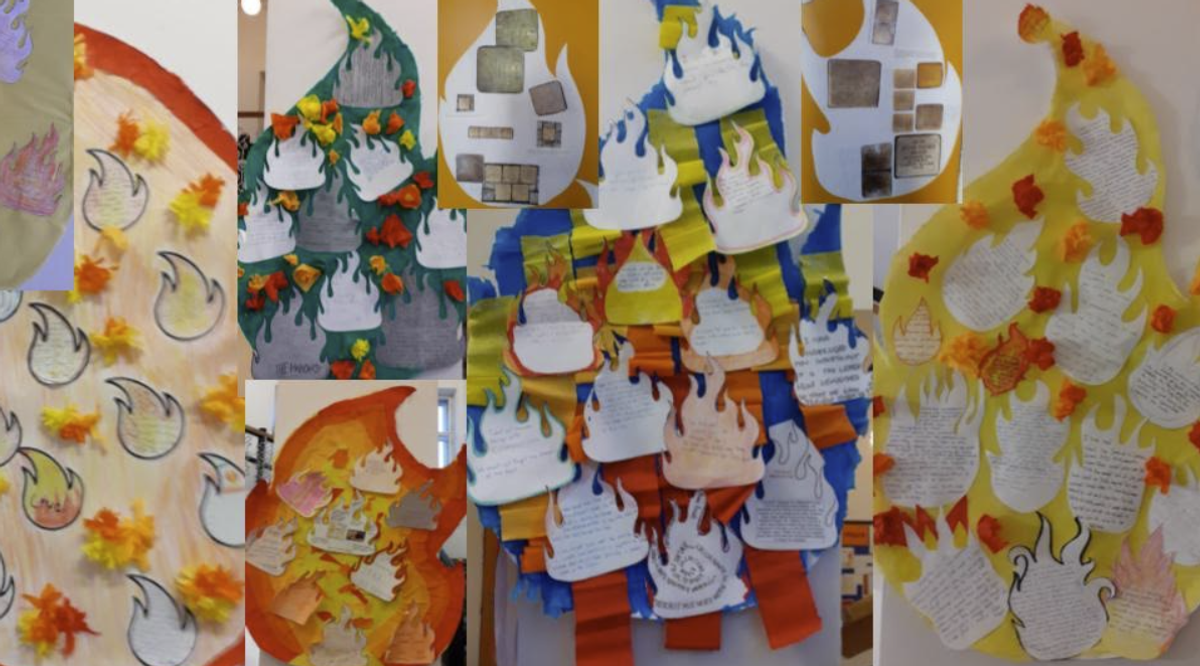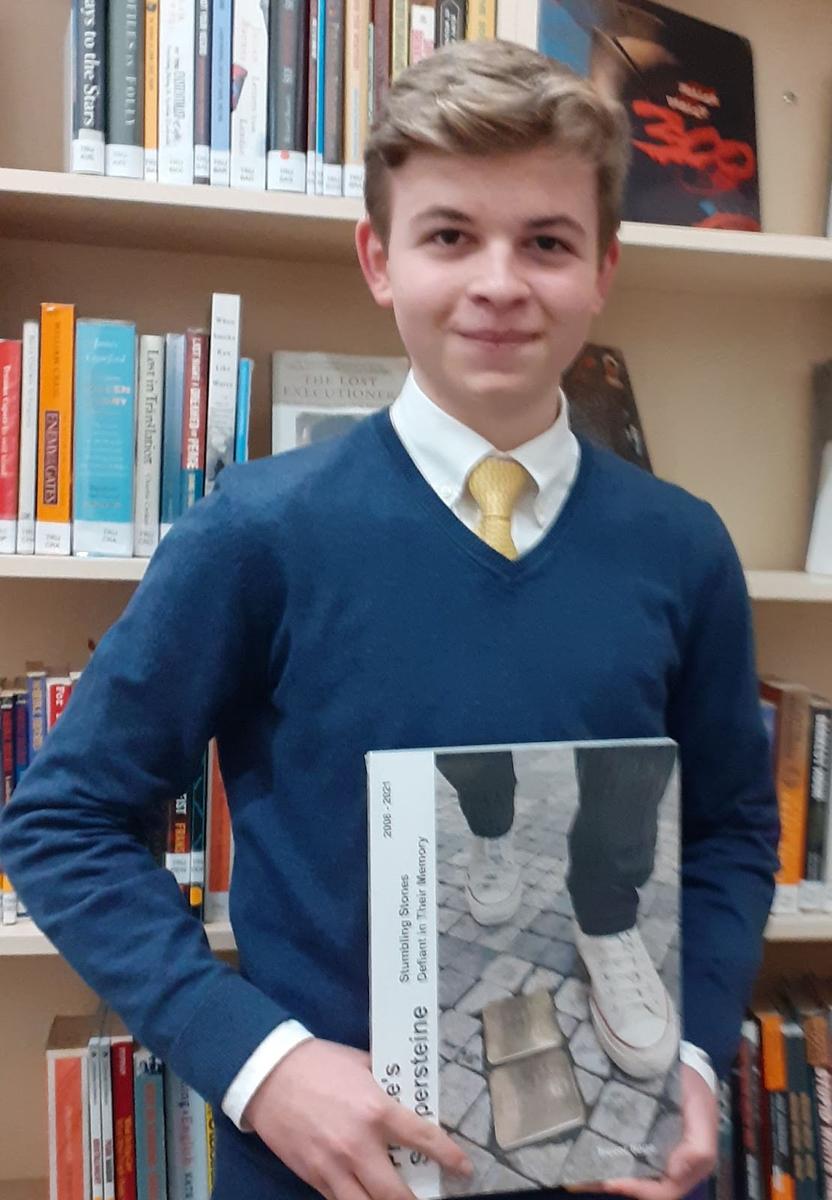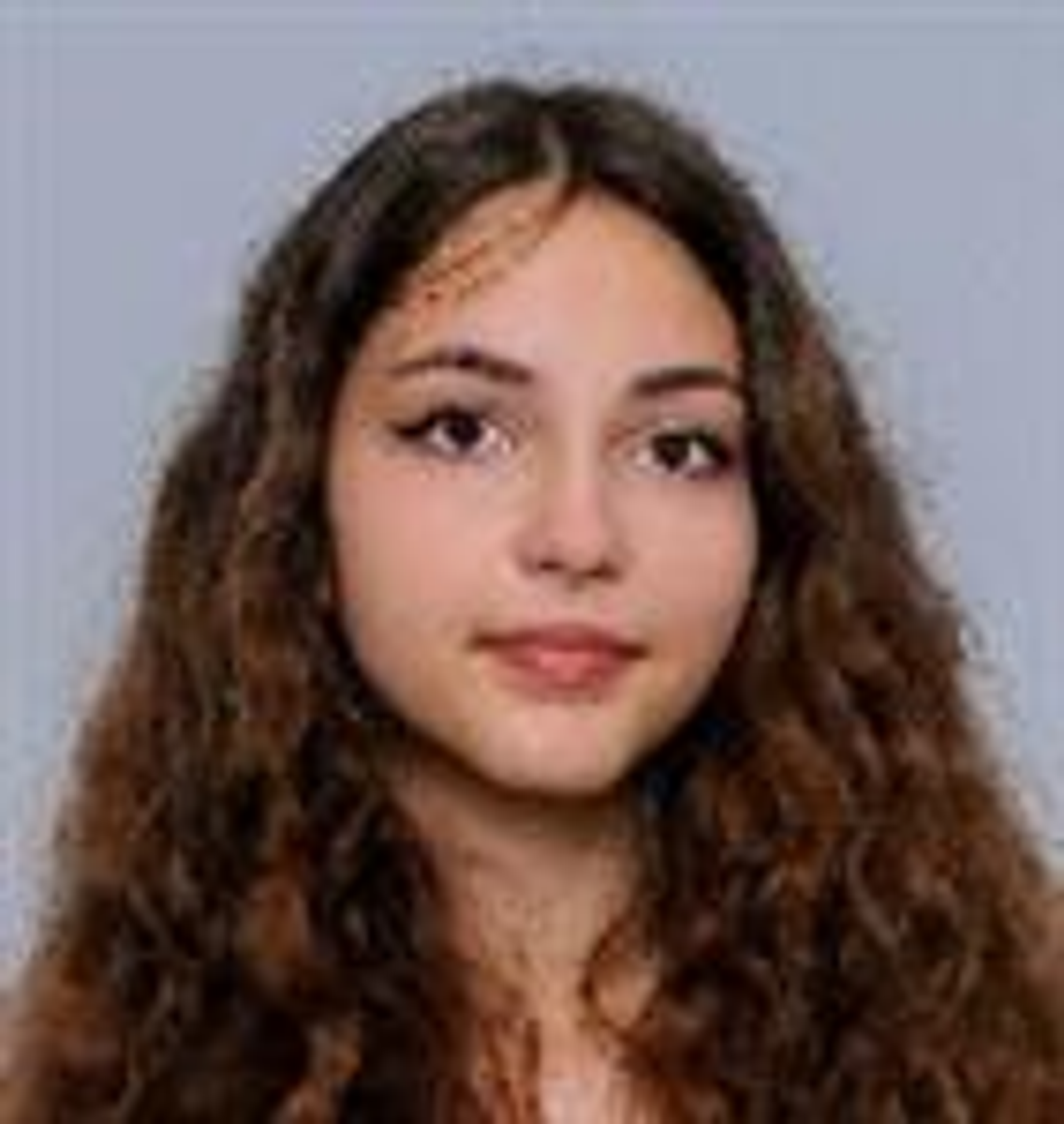Events/Akce
Year 1 students with their Year 6 mentors

Events/Akce
Year 1 students with their Year 6 mentors
During this school year, selected Year 6 students took on support for Year 1 students for the third time and have been helping them handle the first months in a new school. Mentors meet their mentees regularly each month, but in addition to these meetings, Year 1 students have the opportunity to contact their mentors at any time. The programme culminates at the Graduation Ball, where our students symbolically pass the baton - Year 6 students enter the final phase of their studies,


while Year 1 students officially begin their studies. It is a great pleasure to watch how mentors responsibly care for their mentees and pass on their experience to them.
Mrs Švejdová, Deputy Head Co-Curriculum
Během tohoto školního roku vybraní studenti 6. ročníku již potřetí převzali podporu pro studenty 1. ročníku a pomáhají jim zvládnout první měsíce v nové škole. Mentoři se se svými mentees setkávají pravidelně každý měsíc, ale kromě těchto setkání mají studenti 1. ročníku možnost své mentory kdykoli kontaktovat. Program vyvrcholí absolventským plesem, kde naši studenti symbolicky předají štafetu - studenti 6. ročníku vstupují do závěrečné fáze studia, studenti 1. ročníku oficiálně zahajují studium. Je velkým potěšením sledovat, jak se mentoři zodpovědně starají o své svěřence a předávají jim své zkušenosti.
Mgr. Švejdová, zástupkyně ředitele pro mimoškolní aktivity




Holocaust Memorial Day was created on 27 January 2000, when representatives from 46 governments around the world met in Stockholm to discuss Holocaust education, remembrance and research. At the end of the meeting, all the attendees promised to preserve the memory of those who had been murdered in the Holocaust. This year, students in Years 1-4 contributed to a Memorial Flames Display to help them reflect upon the experiences of people affected by the Holocaust, Nazi persecution and other subsequent acts genocide. The design for the Memorial Display was planned by Eliška Jarvisová in Year 5.
Den památky obětí holocaustu vznikl 27. ledna 2000, kdy se ve Stockholmu sešli zástupci 46 vlád z celého světa, aby diskutovali o vzdělávání, vzpomínkách a výzkumu o holocaustu. Na závěr setkání všichni přítomní slíbili, že zachovají památku zavražděných během holocaustu. V letošním roce studenti 1. až 4. ročníku přispěli ke vzpomínkové výstavě plamenů holocaustu, což jim pomohlo zamyslet se nad zkušenostmi lidí zasaženým holocaustem, nacistickou perzekucí a dalšími následnými činy genocidy. Návrh vzpomínkové expozice vytvořila Eliška Jarvisová z 5. ročníku.


Year 2 Lecture - Prague’s Stolpersteine/ Přednáška pro 2. ročník - Pražské Stolpersteiny
In addition to time spent learning about the Holocaust during PSME, Trevor Sage gave a lecture to Year 2. At the end of his talk, he left a copy of his book to be awarded to the student who wrote the best essay about Prague’s Stolpersteine.


Kromě času stráveného studiem holocaustu během předmětu PSME měl pan Trevor Sage přednášku pro 2. ročník. Po přednášce nám nechal výtisk své knihy jako ocenění pro studenta, který napsal nejlepší esej pražských Stolpersteinech, česky též kamenech zmizelých.
Personal Reflection/Osobní úvaha


On the 25th of January, Trevor Sage visited our school and talked to us during our PSME lesson. Trevor Sage was born in Britain but now lives here in Prague and he makes sure that the victims of the Holocaust are remembered in Prague by cleaning the Stoplersteines in Prague. He had a presentation prepared and he talked to us about what he does exactly, how we as students could contribute, and also he explained to us the importance of what he does.
Trevor Sage cleans these stones in Prague even though he isn’t Jewish or Czech and he cleans them with care, he has the pictures of the victim(s) on his tablet in front of him when he cleans them, remembering their tragic story. I find that him dedicating his time to making sure that the poor Jewish people murdered are remembered is extremely honourable. And I think that his dedication and pure purpose impacted me the most.
It is very important to remember the Holocaust for many reasons. One of them is that we have to learn from the past to not repeat the mistakes we made. And in order to do that, we have to understand the past. But also us remembering the Holocaust, raises awareness about xenophobia, antisemitism and hatred. By remembering the Holocaust we fight the people that deny the Holocaust ever happened, the people that are still antisemitic. We also honour the victims that possibly have no family left to remember them, we pay tribute to the 6 000 000+ lives lost.
The Stolpersteine project is an amazing project that helps people remember the Holocaust in their day to day lives, not only on Holocaust Memorial Day. Yesterday I was walking around Prague and found numerous of the Stolpersteine stones and they made me stop and think. That is why I think so highly of the project. Mr Sage’s initiative is very admirable. Cleaning the stones helps people remember the tragic lives lost. When the stones are dirty they aren’t as noticeable. And when the text carved in the stone isn't readable the message passed by the stone isn't as strong.
Mr Sage also mentioned that we can adopt a Stoplersteine stone, near to where we live, and look after it. You can also read 20 names of the Jewish people murdered, to honour their name. Also just talking about it is enough, raising awareness to spread the word.
Eileen Griffin, Year 2


25. ledna navštívil naši školu pan Trevor Sage a hovořil s námi během naší hodiny PSME (občanské nauky). Trevor Sage se narodil v Británii, ale nyní žije zde v Praze a stará se o to, aby jsme si v Praze připomínali oběti holocaustu čištěním pražských Stoplersteinů. Měl připravenou prezentaci a povídal si s námi o tom, co přesně dělá, jak bychom mohli přispět my jako studenti, a také nám vysvětlil důležitost toho, co dělá.
Trevor Sage čistí tyto kameny zmizelých v Praze, i když není Žid ani Čech, a čistí je pečlivě, při čištění má obrázky obětí na tabletu před sebou a vzpomíná na jejich tragický příběh. Připadá mi, že to, že věnuje svůj čas tomu, aby se ujistil, že se památka na ubohé zavražděné židovské lidi uchová, je nesmírně šlechetné. A myslím si, že jeho oddanost a čistý záměr mě oslovily nejvíc.
Je velmi důležité připomínat si holocaust, a to z mnoha důvodů. Jedním z nich je, že se musíme poučit z minulosti, abychom neopakovali chyby, které jsme dříve udělali. A abychom to dokázali, musíme porozumět minulosti. Navíc také tím, že si připomínáme holocaust, zvyšujeme povědomí o xenofobii, antisemitismu a nenávisti. Tím, že si připomínáme holocaust, bojujeme proti lidem, kteří popírají, že k holocaustu vůbec došlo, proti lidem, kteří jsou stále antisemitisté. Připomínáme si také oběti, po kterých možná nezůstala žádná rodina, která by si na ně vzpomněla, a vzdáváme hold více než 6 000 000 ztraceným životům.
Projekt Stolpersteine je úžasný, protože pomáhá lidem připomenout si holocaust v jejich každodenním životě, nejen v Den památky obětí holocaustu. Včera jsem se procházela po Praze a našla jsem řadu kamenů Stolpersteine a donutilo mě to se zastavit a přemýšlet. Proto hodnotím projekt tak kladně. Iniciativa pana Sage je velmi obdivuhodná. Čištění kamenů pomáhá lidem vzpomenout si na tragické ztracené životy. Když jsou kameny špinavé, nejsou tak nápadné. A když text vytesaný do kamene není čitelný, zpráva předávaná kamenem není tak silná.
Pan Sage také zmínil, že můžeme adoptovat kámen Stoplerstein poblíž místa, kde žijeme, a starat se o něj. Můžeme si také přečíst 20 jmen zavražděných židovských lidí, abychom jejich jméno uctili. Stačí však i o tom mluvit, zvyšovat povědomí, a tím tuto myšlenku šířit.
Eileen Griffin, Year 2
Winning Essay/Vítězná esej


During the time of the nazi regime there were many who worked against it on their own knowing that, if caught, they would be killed. But this didn’t stop many, including Milena Jesenská. When researching her, I found her career and connections to many of the great writers and intellectuals of the early 20th century, especially Franz Kafka, fascinating. Apart from her professional doing, following the occupation of Czechoslovakia, she helped the Jewish and political refugees escape prosecution and their fate in concentration camps yet she herself decided to stay to keep aiding them. Milena Jesenská of course wasn’t the only one to do this but the overall act of selflessness and helping from her own initiative even before Germany conquered the rest of the country while she herself wasn’t Jewish or otherwise persecuted (she was sent to a concentration camp only after the Gestapo found out about her doing) is noble to say the least. That really spoke to me and made me further understand why it’s important to remember the tragedy that is the Holocaust.
Such horrors of a genocide mustn’t be forgotten. It happened before, it can happen again and in order to not do that, we must remember. Not remembering would be disregarding the innocent victims of the regime, which would be a tragedy in itself. A terrific way to not forget, in my opinion, is the Stolpersteine project. It reiterates the fact that every one of those deaths was indeed a life, a person who lived and it does that by pointing out the locations where those people lived (or worked). It helps put the unbelievable amount of people who died into reality. Statistics are nice but only few can really picture what they represent and the Stolpersteine project does that perfectly. Whenever I’m walking somewhere in Prague and I happen to cross one of those stones, I stop for a moment to read it, to see who that person was and it makes me think. And I probably wouldn’t be able to do that if it weren’t for Mr. Sage as he not only honours the victims but also helps the cause to not forget, as the ones that aren’t clean are barely readable.
I think it’s a very nice initiative that helps to not forget and I respect and appreciate what Mr. Sage does very much, considering he isn’t local and doesn’t have a connection to the victims or regime, despite that he does what he does. This whole experience made me think about what I can do and, to put it simply, all I can do is help remember and not forget. I understand that that’s fairly vague so to narrow it down, I intend to research about more victims, more people who were killed by the Nazi regime, to tell people about the Stolpersteine project and what it is when seeing one on the sidewalk and overall just keep remembering. There is a reason why we have a dedicated day of the year to remember and I aim to honour that. We cannot forget.


Tadeáš Vácha, Year 2
Year 3 Lecture - The Roots of Nazi Racism/Přednáška pro 3. ročník - Kořeny nacistického rasismu
Dr. William Eddleston, professor of History at Anglo-American University and lecturer at Charles University, gave a lecture on the roots of Nazi racism to the Y3 Changing Times students as part of their learning about the Holocaust.
Dr. William Eddleston, profesor historie na Anglo-American University a lektor na Univerzitě Karlově, přednášel pro 3. ročník na téma kořeny nacistického rasismu jako součást jejich učiva o holocaustu.
Personal Reflection/Osobní úvaha


Overall I really enjoyed the lecture. However, if I had to specify one thing that really fascinated me, it would have to be the link the lecturer made between colonialism and the roots of Nazi racial violence. It had never occured to me that the Nazi denial of pre-existing statehood and soveriegnty meant that they were essentially applying colonialism to Europe. The death camps could be seen as a wider colonial project, since it was an effort to kill the “racially undesirable” and replace them with pure, aryan “settlers”. What also interested me was that fascists loved modernity and considered the US the embodiment of everything modern, radical and progressive. The Nazi admiration for American eugenics led to the Nuremburg laws. The government in the US was the first to interfere in reproduction as well as passing racially restrictive immigration laws, therefore the Nuremberg laws were drawing from the American parallel.
Until Kristallnacht in Germany, the US privatised violence against the Jews (mostly caused by the KKK), which was worse than anything seen in Germany. Hitler was also an avid reader of Karl May, who wrote novels of fictitious travels set in the American north west. There is a clear analogy between Karl May’s book, Manifest Destiny, which advocates expanding and creating a dominion in North America, and Hitler’s concept of lebensraum. The belief that settlers are entitled to conquer land because they are more industrialized can be seen in both Manifest Destiny and Hitler’s Second Book.
In conclusion, I found that this lecture helped me gain more insight into the roots of Nazi violence and how they led to the subsequent Holocaust.
Lea Marie Rosická, Year 3
Celkově se mi dnešní přednáška moc líbila. Pokud bych však měla vybrat jednu věc, která mě nejvíce zaujala, muselo by to být spojení, které lektor vytvořil mezi kolonialismem a kořeny nacistického rasového násilí. Nikdy mě nenapadlo, že nacistické popření již existující státnosti a suverenity znamenalo, že v podstatě uplatňují kolonialismus v Evropě. Tábory smrti by mohly být považovány za širší koloniální projekt, protože šlo o snahu zabít „rasově nežádoucí“ a nahradit je čistými, árijskými „osadníky“. Zaujalo mě také to, že fašisté milovali modernu a považovali USA za ztělesnění všeho moderního, radikálního a pokrokového. Nacistický obdiv k americké eugenice vedl k norimberským zákonům. Vláda v USA byla první, kdo zasáhl do reprodukce a také přijal rasově omezující imigrační zákony, proto norimberské zákony čerpaly z americké paralely.
Až do Křišťálové noci v Německu USA privatizovaly násilí proti Židům (většinou způsobené KKK), což bylo horší než cokoli z dění v Německu. Hitler byl také vášnivým čtenářem Karla Maye, který psal romány o fiktivních cestách odehrávajících se na americkém severozápadě. Existuje jasná analogie mezi knihou Karla Maye Manifest Destiny, která obhajuje expanzi a vytvoření nadvlády v Severní Americe, a Hitlerovým konceptem lebensraum. Víra, že osadníci mají právo dobýt půdu, protože jsou více industrializovaní, je patrná jak v Manifest Destiny, tak v Hitlerově druhé knize.
Závěrem bych ráda řekla, že tato přednáška mi pomohla zjistit více o kořenech nacistického násilí a o tom, co vedlo k následnému holocaustu.
Lea Marie Rosická , 3. ročník